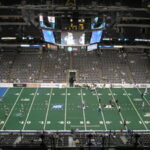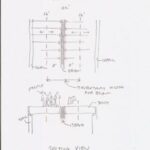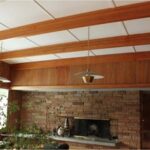Draft – Comments Welcome
Outline
- Introduction
- Hire an Engineer
- Prescriptive Design
- Information Provided by Industry / Manufacturers
- Software from Industry / Manufacturers
- Commercial Design Software
- Calculation using Basic Principles
- Conclusion
- References
1. Introduction
There are many ways to determine the proper size beam for a floor, especially for a floor in a `residence’. For a floor beam in a `significant’ structure, whether that structure is a significant (`huge’) residence, or a commercial building, or a `sky scraper’, often a structural engineer is employed. And rightfully so. Significant structures are complicated, and we want the design of such to be by people who `know what they are doing’, and know all the `issues’ involved. But for structures of lesser importance, why not let non-engineers tackle the problem? And the building codes generally allow for such, as long as `you know what you are doing’ and that what you come up with is to the satisfaction of the building official.
2. Hire an Engineer
For any structure you can simply hire an engineer to determine the proper size beam. That’s what they do. But they (we) are expensive. They know the issues involved, the building codes, and most carry liability insurance. On significant structures you will certainly want to hire an engineer, and their fees should be included in the building construction budget. Generally the Structural Engineer comes into a project `under’ the Architect. But on some projects the `Architect’ is bypassed, and things get `designed’ by Owners, Developers, Contractors, etc. And so sometimes as engineers we are hired by … just about anybody. And if you are the Owner of a project, or the Owner’s agent, the building official may require an `engineered’ solution – so you may be calling me. But that is not the purpose of this article. In this article I want to show some other ways, and some of these ways are ways we (as engineers) use, if you end up calling on us.
3. Prescriptive Design
Prescriptive design, by its very intention, provides for `design’ without the need for engineering. But it is limited in its use. For wood structures prescriptive (non-engineered) design is allowed for `Conventional Light Frame (Wood) Construction’. And the most common application of Conventional Light Frame Construction is for Residential Construction. The limitations for the use of Conventional Construction can be found the opening of Section 2308 in the International Building Code (IBC). I will not get into those limitations here. But, assuming we are within those limitations, let’s use prescriptive design to determine a beam for our previous example problem (here).
We will use Table 2308.9.6 of the IBC. Note, however, that the terminology is `girder’ instead of beam. And, the beam (girder) options are rather limited; we will be limited to selecting members that will be made up of plies of 2 in. nominal dimension lumber. But, covered with sheet-rock, mudded, taped, and painted, they will be fine. Or we can `finish’ them some other way. If we want something different, say a glu-lam beam, or big rough-sawn beam, we will need to find some other way of determining the proper size.
Table 2308.9.6 deals with girders (and headers) for `Interior’ bearing walls. And the values provided a function of building width, span, and whether carrying one floor or two. In our particular example we are carrying only one floor, and the building width is 32 ft. Values for widths of 20, 28, and 36 (only) are provided, but the footnotes allow us to interpolate for intermediate widths. Load are not listed as options; but since the table is for Conventional Light Frame Construction, for which the Floor Live loads are limited to 40 psf, and the average floor Dead loads are limited to 15 psf. So, we are good with our example (assuming our example also satisfies all the other limitations, which for now we will assume it does). (Note: I list the limitations for Conventional Light Frame (Wood) Construction in another article … here. My intent with providing any information from the `code’, or anywhere else, is not to entice you to try and design with my information and not the information referenced, but all the more motivate you to get the referenced material and use it yourself. You may not like me saying this, but, … “Shudder the thought of anyone designing, or building, a structure, and not having his/her own copy of the building code.”)
For the sake of illustration, let’s say our span is 8′-0″.
Okay, let’s do it … from the Table …
Building width 28 ft … one floor, 3-2×12 will span 7-10, …
Building width of 36 ft … one floor, 3-2×12 will span 8-10.
Simple interpolation means … that for a width of 32 ft, which is half way between 28 and 36, we can span 8-4 (half way in between 7-10 and 8-10).
Since our maximum allowable span is 8’4″, and our intended span is 8′-0″ … good.
Note that the Table values don’t go out much past 10 ft … if we need a girder or beam for much longer spans, we’ll need `engineered materials’, and maybe even need to contact an engineer.
If we look further at the information provided in the Table, we’ll see that the lumber involved is Douglas Fir / Larch, Grade # 2. We ended up with a 12 in. (nominal) deep girder, which will frame nicely with the 2×12 joists. In fact, the 3-ply 2×12 girder bottom will be flush with the joists bottoms and the girder will `hide’ in the floor/ceiling.
The proper size beam (girder) is …
3-Ply 2×12 DF/L (Douglas Fir-Larch) # 2 … (clear span 8′-0″)
The actual girder may need to be a bit longer than 8′-0″, depending on how it frames into / onto supporting walls or posts. Generally such a girder would bear on several supporting studs at each end. In fact, Table 2308.9.6 provides the number of studs needed, in our case, 2 (each end of girder).
If our opening is larger than that (8 ft), we could use, say, two 8 ft beams end to end, with a post in the center, and have a 16 ft opening. The post in the center would need to have 2 + 2 = 4 studs.
4. Information Provided by Industry / Manufacturers
Let’s say we want to use a glu-lam beam for the above application (`glu-lam’ short for `Glued-Laminated Timber’). A glu-lam is a manufactured product and we generally cannot directly prescribe such from the building codes. However, manufacturers still want you to specify their products, so they (or organizations of which they are members) will provide ways for you to determine which size(s) you need. One such organization for glued-laminated timber is the American Institute of Timber Construction (AITC). Let’s go to their website and see if we can determine a suitable glu-lam. Yes, … their home (on the Internet) is … http://aitc-glulam.org/ …. and if we go under `Technical Information’ … and then … `Floor Beams Floor Live Load’ … we find the following capacity table (for Douglas Fir / Larch beams) …
http://aitc-glulam.org/pdf/Capacity/DF_27.PDF
The way the Table is set up, we need to go back to our original example and get the `line loads’ … and add them up to give us a total uniform load of … 640 plf Live + 176 plf Dead = 816 plf Total load.
From the Table the following sizes are suitable (beam capacities greater than or equal to 816 plf for a span of 8 ft):
3-1/8 in. x 9 in.
5-1/8 in. x 7.5 in.
… and so on.
The required sizes are smaller … that’s because glu-lams, everything else equal, are generally stronger and stiffer that the equivalent amount of dimension lumber (in the same species). There will be less wood, but glu-lams are generally more expensive. Note in our case that we get a beam (girder) that is less deep than the joists. The girder would really hide in the floor/ceiling system (and indeed might be awkward to frame), or in some cases the it could be framed below the joists, as long as it doesn’t encroach too much on headroom.
So …
3-1/8 x 9 OR 5-1/8 x 7.5 … Douglas Fir – Larch Fb = 2400 psi, E = 1,800,000 psi, clear span 8′-0″.
Hopefully it is obvious by now that glu-lam beams become real attractive for longer spans, or higher loads. For example, a glu-lam of size 5-1/8 x 12 (roughly the size of the 3-ply 2×12) will carry 816 plf clear out to 14 ft. And bigger beams (way) beyond that!
(A 5-1/8 in. x 15 in. glu-lam beam could, for example, carry the 816 plf out to 18 ft. If the joists frame to the sides of the beam, the beam would stick down below the ceiling some 3 inches. The exposed part of the beam could be left exposed, or covered by whatever means. )
In terms of presenting information to a building official (without an engineer), you could provide calculations similar to the ones provided in the previous example, with a printout of the Table, and say, “Here!” And the building official may or may not approve. Probably the information from AITC will have all kinds of disclaimers with it. It is provided to help, but not to circumvent prudent design. If you indeed know what your are doing, and can provide the numbers and documentation to support it, there is a good chance the building official will approve.
5. Software from Industry / Manufacturers
Many manufacturers so want you to buy their products that they have come up with `design software’. Some of this software is available for download on the Internet, some is on the computers of your local `supplier’ (building supply store), and some is available for the asking from manufacturer representatives (`reps’). Some software is easy to use; some is cumbersome. And guess what! … the `beams’ that they `cough up’ for answers are their beams. (Duhhhhh.) And the printouts are plastered with disclaimers. I am not against their softwares, and sometimes use them, but as a `designer’ I also find them limiting.
6. Commercial Software
If you really want to get into beam design you can purchase commercially available beam design software. Software ranges from affordable to expensive, simple to robust, and in between. Some is free (scary!), and many softwares have free trial versions. Some will do just a single beam, or a single simple beam, while others do complicated single beams, or multiple beams, or WHOLE STRUCTURES. The advantage to commercially available design software is that it is generally targeted for the designer and is not biased to particular products or manufacturers. And the software printout, helps, and user agreements have all kinds of disclaimers. Yes, you, the designer, need to know what you are doing.
(Note: yeah, the commercial design software I use gives me the same thing for the problem, span 8 ft, same loads, etc. … 3-ply 2 x 12 DF-L # 2.)
7. Calculations using Basic Principles
We can also determine the proper beam size by basic engineering mechanics and the properties of the available materials. It is fun, if you know what you are doing, but also time consuming. I’ll illustrate in other lessons.
8. Conclusion
We see now that in some cases we can determine the proper floor beam size using a number of methods. For Conventional Light Frame (Wood) Construction we can determine the beam size prescriptively (`cook-book’ from the `Code’). But we are in the end limited to relatively short spans (and dimension lumber). For longer spans we might venture into manufactured wood, for example, glu-lam. Manufacturers provide aids (printed, electronic, and software) to `help us’ (select their products). Also there is commercial software available (that is not manufacturer or industry specific). We can also crunch out our design using basic principles and `hand calculations’. I reserve this approach for other lessons. In all design situations we must `know what we are doing’. Or hire an engineer. And engineers employ many of these same methods, supposedly knowing what they are doing.
9. References
American Institute of Timber Construction, 7012 S. Revere Parkway Suite 140, Centennial, CO 80112, www.aitc-glulam.org.
International Building Code, International Code Council, 4051 West Flossmoor Road, Country Club Hills, IL 60478.





